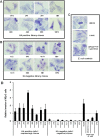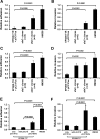Colonic mucosa-associated diffusely adherent afaC+ Escherichia coli expressing lpfA and pks are increased in inflammatory bowel disease and colon cancer
- PMID: 23846483
- PMCID: PMC3995253
- DOI: 10.1136/gutjnl-2013-304739
Colonic mucosa-associated diffusely adherent afaC+ Escherichia coli expressing lpfA and pks are increased in inflammatory bowel disease and colon cancer
Abstract
Objective: Colonic mucosa-associated Escherichia coli are increased in Crohn's disease (CD) and colorectal cancer (CRC). They variously haemagglutinate, invade epithelial cell lines, replicate within macrophages, translocate across M (microfold) cells and damage DNA. We investigated genes responsible for these effects and their co-association in colonic mucosal isolates.
Design: A fosmid library yielding 968 clones was prepared in E coli EPI300-T1 using DNA from a haemagglutinating CRC isolate, and resulting haemagglutinating clones were 454-pyrosequenced. PCR screening was performed on 281 colonic E coli isolates from inflammatory bowel disease (IBD) (35 patients), CRC (21) and controls (24; sporadic polyps or irritable bowel syndrome).
Results: 454-Pyrosequencing of fosmids from the haemagglutinating clones (n=8) identified the afimbrial adhesin afa-1 operon. Transfection of afa-1 into E coli K-12 predictably conferred diffuse adherence plus invasion of HEp-2 and I-407 epithelial cells, and upregulation of vascular endothelial growth factor. E coli expressing afaC were common in CRC (14/21, p=0.0009) and CD (9/14, p=0.005) but not ulcerative colitis (UC; 8/21) compared with controls (4/24). E coli expressing both afaC and lpfA (relevant to M-cell translocation) were common in CD (8/14, p=0.0019) and CRC (14/21, p=0.0001), but not UC (6/21) compared with controls (2/24). E coli expressing both afaC and pks (genotoxic) were common in CRC (11/21, p=0.0015) and UC (8/21, p=0.022), but not CD (4/14) compared with controls (2/24). All isolates expressed dsbA and htrA relevant to intra-macrophage replication, and 242/281 expressed fimH encoding type-1 fimbrial adhesin.
Conclusions: IBD and CRC commonly have colonic mucosal E coli that express genes that confer properties relevant to pathogenesis including M-cell translocation, angiogenesis and genotoxicity.
Keywords: BACTERIAL ADHERENCE; BACTERIAL INTERACTIONS; BACTERIAL PATHOGENESIS; E. COLI; GUT INFLAMMATION.
Figures




Similar articles
-
The prevalence of mucosa-associated diffusely adherent Escherichia coli in children with inflammatory bowel disease.Adv Clin Exp Med. 2019 Jul;28(7):899-905. doi: 10.17219/acem/94149. Adv Clin Exp Med. 2019. PMID: 31066244
-
Point mutations in FimH adhesin of Crohn's disease-associated adherent-invasive Escherichia coli enhance intestinal inflammatory response.PLoS Pathog. 2013 Jan;9(1):e1003141. doi: 10.1371/journal.ppat.1003141. Epub 2013 Jan 24. PLoS Pathog. 2013. PMID: 23358328 Free PMC article.
-
Microevolution in fimH gene of mucosa-associated Escherichia coli strains isolated from pediatric patients with inflammatory bowel disease.Infect Immun. 2012 Apr;80(4):1408-17. doi: 10.1128/IAI.06181-11. Epub 2012 Jan 30. Infect Immun. 2012. PMID: 22290143 Free PMC article.
-
Adherent-invasive Escherichia coli in inflammatory bowel disease.Gut. 2018 Mar;67(3):574-587. doi: 10.1136/gutjnl-2017-314903. Epub 2017 Nov 15. Gut. 2018. PMID: 29141957 Review.
-
Escherichia coli-host macrophage interactions in the pathogenesis of inflammatory bowel disease.World J Gastroenterol. 2014 Jul 21;20(27):8751-63. doi: 10.3748/wjg.v20.i27.8751. World J Gastroenterol. 2014. PMID: 25083050 Free PMC article. Review.
Cited by
-
Quantitative profiling of colorectal cancer-associated bacteria reveals associations between fusobacterium spp., enterotoxigenic Bacteroides fragilis (ETBF) and clinicopathological features of colorectal cancer.PLoS One. 2015 Mar 9;10(3):e0119462. doi: 10.1371/journal.pone.0119462. eCollection 2015. PLoS One. 2015. PMID: 25751261 Free PMC article.
-
Escherichia coli from Crohn's disease patient displays virulence features of enteroinvasive (EIEC), enterohemorragic (EHEC), and enteroaggregative (EAEC) pathotypes.Gut Pathog. 2015 Jan 29;7(1):2. doi: 10.1186/s13099-015-0050-8. eCollection 2015. Gut Pathog. 2015. PMID: 25653719 Free PMC article.
-
Gut bacteria promote proliferation in benign S/RG/C2 colorectal tumour cells, and promote proliferation, migration and invasion in malignant HCT116 cells.Sci Rep. 2023 Oct 12;13(1):17291. doi: 10.1038/s41598-023-44130-6. Sci Rep. 2023. PMID: 37828235 Free PMC article.
-
From promotion to management: the wide impact of bacteria on cancer and its treatment.Bioessays. 2014 Jul;36(7):658-64. doi: 10.1002/bies.201400015. Epub 2014 Apr 22. Bioessays. 2014. PMID: 24752750 Free PMC article.
-
A prospective analysis of mucosal microbiome-metabonome interactions in colorectal cancer using a combined MAS 1HNMR and metataxonomic strategy.Sci Rep. 2017 Aug 21;7(1):8979. doi: 10.1038/s41598-017-08150-3. Sci Rep. 2017. PMID: 28827587 Free PMC article.
References
-
- Flanagan P, Campbell BJ, Rhodes JM. Bacteria in the pathogenesis of inflammatory bowel disease. Biochem Soc Trans 2011;39:1067–72 - PubMed
-
- Darfeuille-Michaud A, Neut C, Barnich N, et al. Presence of adherent Escherichia coli strains in ileal mucosa of patients with Crohn's disease. Gastroenterology 1998;115:1405–13 - PubMed
-
- Martinez-Medina M, Aldeguer X, Gonzalez-Huix F, et al. Abnormal microbiota composition in the ileocolonic mucosa of Crohn's disease patients as revealed by PCR-denaturing gradient gel electrophoresis. Inflamm Bowel Dis 2006;12:1136–45 - PubMed
-
- Martinez-Medina M, Aldeguer X, Lopez-Siles M, et al. Molecular diversity of Escherichia coli in the human gut: new ecological evidence supporting the role of adherent-invasive E. coli (AIEC) in Crohn's disease. Inflamm Bowel Dis 2009;15:872–82 - PubMed
-
- Martin HM, Campbell BJ, Hart CA, et al. Enhanced Escherichia coli adherence and invasion in Crohn's disease and colon cancer. Gastroenterology 2004;127:80–93 - PubMed
Publication types
MeSH terms
Substances
Associated data
- Actions
Grants and funding
LinkOut - more resources
Full Text Sources
Other Literature Sources
Miscellaneous
